Getting Settled

Although by 1620 Massachusetts was being settled by English immigrants seeking economic opportunity and religious freedom, the Colony’s District of Maine drew few permanent settlers until the mid-18th century. A few coastal settlements struggled against American Indian raids, which usually drove the surviving pioneers back to Essex County, Massachusetts. These Abenakis—most notably under the leadership of Chief Warumbee (also spelled Worumbo)—defended their land against the incursion of the white settlers. Their largest settlements in the area were probably near present day Lisbon Falls and Auburn (Chief Warumbee’s fort near Auburn was captured in 1690 when Major Church led an army up the Androscoggin River). By 1740 or so, most of the Native Americans had been killed or driven away. The end of the French and Indian War in 1759 encouraged emigration to Maine from other colonies; few settlers came directly from the British Isles to Maine.
Durham lies within the broad charter granted in 1620 by James I to the Council of Plymouth, a group of 40 noblemen and gentlemen. It in turn sold the land to various men whose holdings were further enlarged by a deed from six of the American Indian chiefs: Warumbee, Darumkine, Wihikermet, Domhegon, Heonogasset and Numbenemet. Later, a group of gentlemen and Boston financiers known as the Pejebscot Proprietors gained a patent for the vast lands along the Androscoggin River, including what is now Harpswell, all the way through Brunswick and up to Auburn. Much of this was uninhabited until the British victory in 1759.
The second tier of settlements followed long after the coastal ones. In a deed dated November 14, 1761, David Dunning purchased for 33 pounds six square miles of land to be laid out as a town to be named Royalsborough (later Durham).
Royalsborough was named after British General Isaac Royal, who owned a large tract of land near the mouth of the Royal River; Royalston, Massachusetts also bears his name. Being loyal to Britain, the Royal family left the area at the start of the Revolutionary War.

